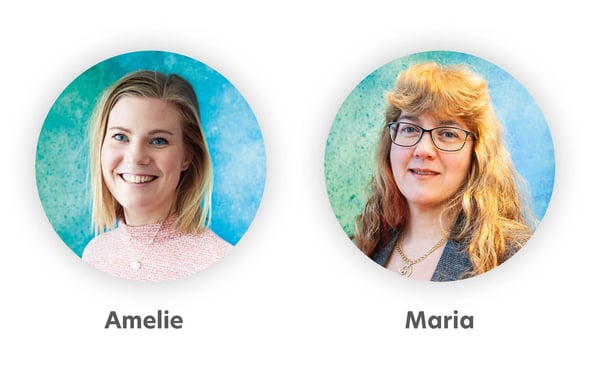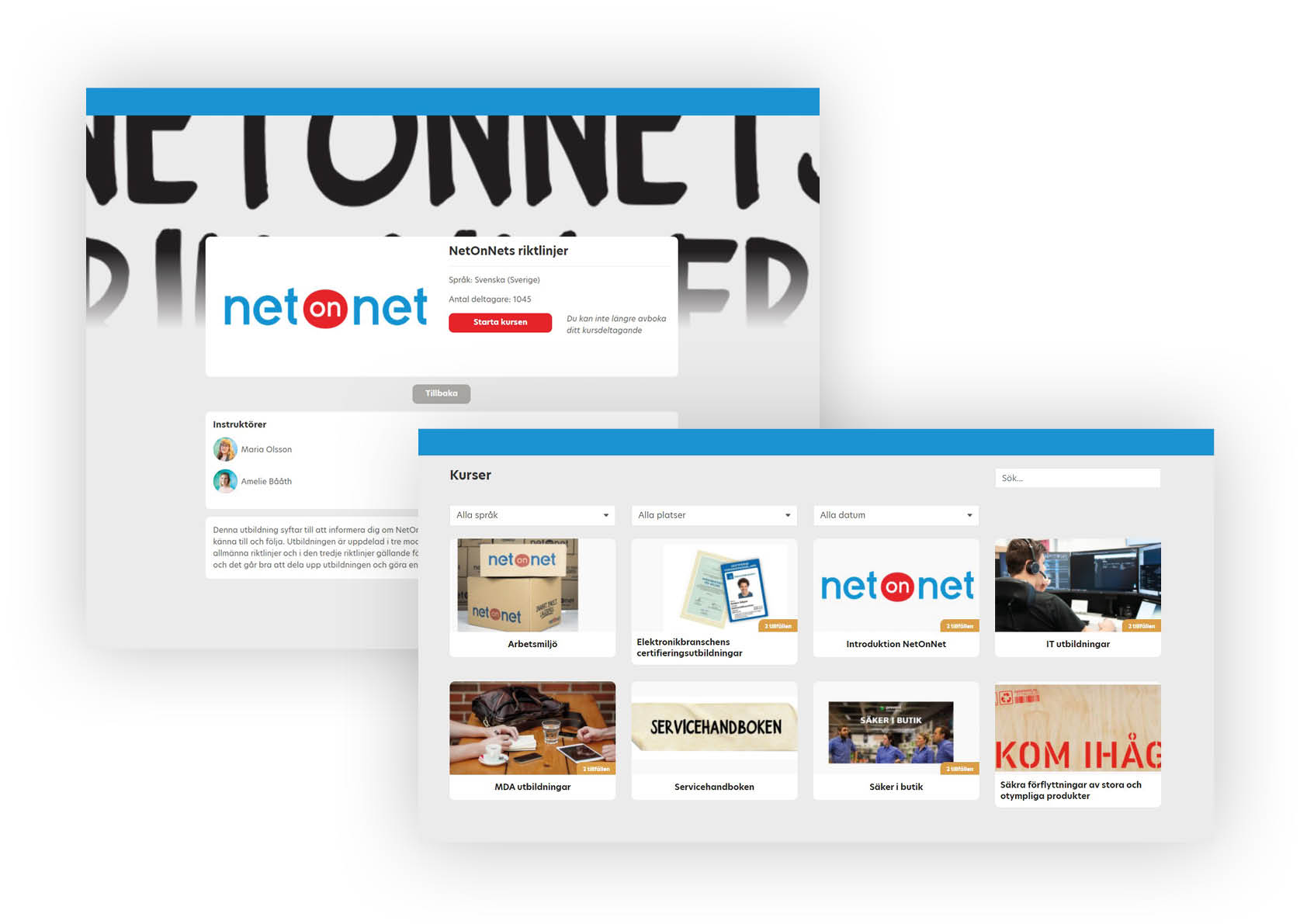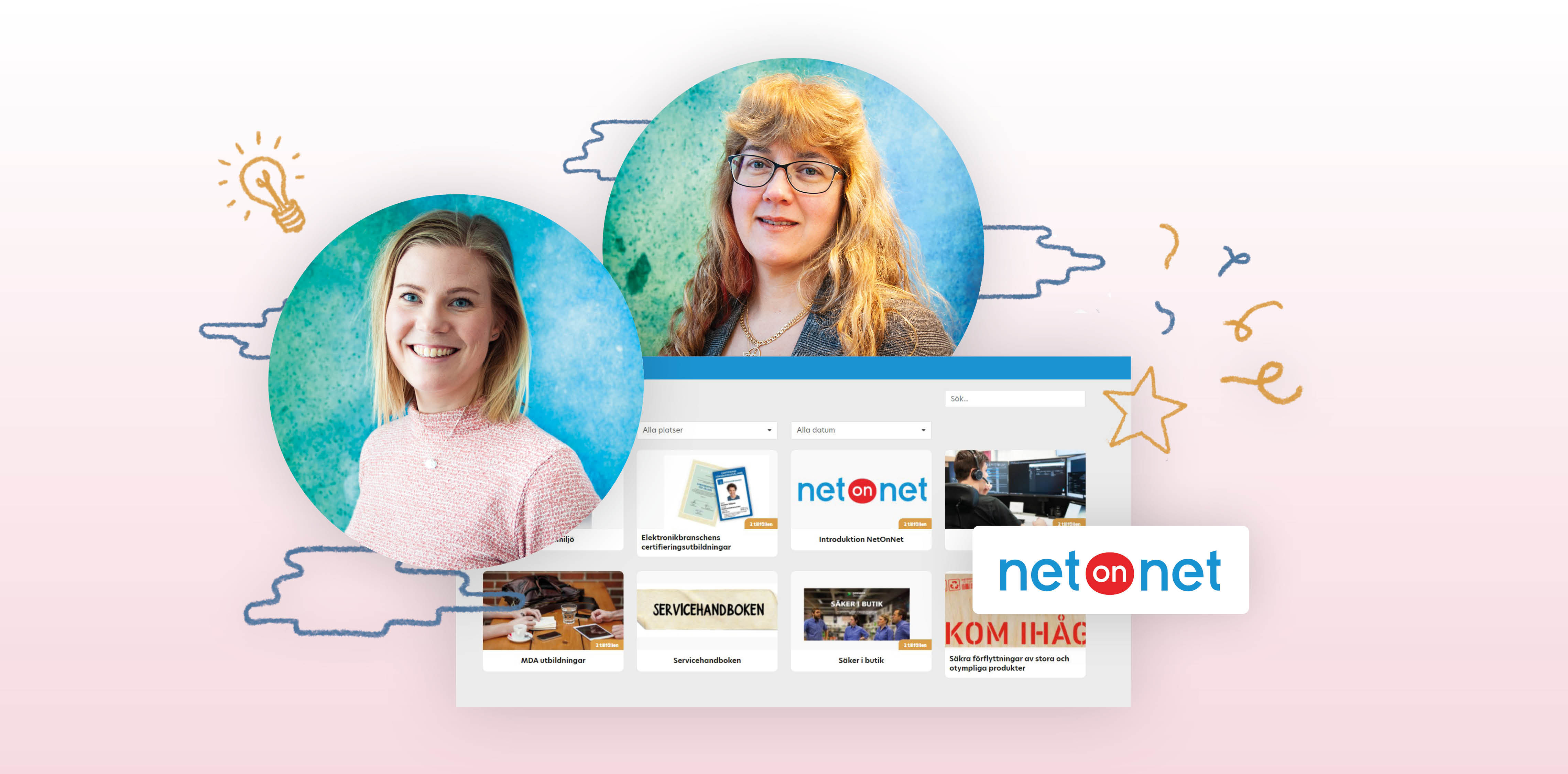The successful Swedish retail chain NetOnNet started in 1999 with a simple business idea: to sell consumer electronics at lower prices than in regular stores. At first they only sold their products online directly from the warehouse shelves. In 2001, online sales were supplemented with physical stores or "stock stores" where you shop at the same low prices as online. Today NetOnNet sells to consumers and companies through e-commerce and 30 stock stores in Sweden and Norway.
NetOnNet works diligently with digital learning and has in a very short time built up an academy with courses. We had a conversation with their two HR Business Partners Amelie Bååth and Maria Olsson who work strategically and operationally with internal competence development. In this story, you get insight into how they work and take part in their learnings and tips from the journey they make.

Amelie, explain what you do at NetOnNet?
- I work as a strategic HR Business Partner since January 2021. This means that I help develop our processes and working methods. Right now, we focus mainly on our systems where Learnifier’s platform is one of the new systems we work with.
And Maria, what is your role and your focus?
- I am an HR Business Partner. I work very close to our stores, our stock stores, together with our Stock Store Managers and our Regional Managers. I support them in various issues. A major focus in my role is the stock store employees, their work environment, rehabilitation, etc. I also work a lot with our processes, negotiations, etc. In short, it is about how we work together with the stock store employees in the simplest way.
“We now focus on getting all the processes in place and on making the systems work for us. Now it feels like we’re at the forefront with a lot of things, which is great.”
How many are you at HR?
- We’re four people working with HR. Two HR Business Partners who work operationally, a strategist and our HR Manager. And also two more colleagues who work with salaries.
How many employees are in the organization in total?
- About 1000 employees.
What are your key markets today?
- Sweden and Norway.
What's the best part about your jobs?
- Amelie: To be involved in developing and thinking about how we should work with HR in the future. We are going through a large digitization internally – from a lot of manual paperwork to becoming digital. We now focus on getting all processes in place and on making the systems work for us. It feels like we’re at the forefront with a lot of things now which is great.
- Maria: It’s the same for me. I’m also involved in mapping out ways of working with many new systems as support. Things happen all the time and you are constantly challenged to be innovative in supporting the Managers in their work.
What is the biggest challenge?
- Amelie: Change is a challenge. Therefore, we strive to create interest and understanding to get everyone on the journey that we are now on.
Maria: It can be difficult to create time for the stock store employees for example to sit in front of a computer and learn.
You work with a learning platform to share knowledge.
Who are you conveying knowledge to and why?
- Today, mainly employees in Sweden have access to the portal. We haven’t used it that long, about six months. During this time, we have focused on the employees in our warehouse and our stock stores. We’ve for example had courses that strengthen the internal knowledge of NetOnNet and working environment training on for example fire safety and ergonomics. We’ve also focused a lot on developing our leaders and on creating a good onboarding. All this can look a little different depending on what role you have with us.
“We expect the employees to complete the courses to which they receive automatic invitations. Apart from that, the course catalog is open to everyone. You can go in, have a look and attend the courses you are interested in."
 Are the courses compulsory?
Are the courses compulsory?
- It varies. For example, we have an onboarding that applies to all new employees, but it looks different depending on where in NetOnNet you work. We have used automation when we assign training, which makes it easy for us to automatically send out certain trainings to employees in the stock shops and other training to employees in the office for example. If you’re new in a leading role, you will also receive invitations to various leadership trainings.
We expect the employees to complete the courses to which they receive automatic invitations. Apart from that, the course catalog is open to everyone. You can go in, have a look and attend the courses you are interested in. We think it’s important for our employees to be able to see what competences other people and departments develop.
How was this knowledge communicated before?
- We’ve had other tools for learning before Learnifier but felt that they didn’t really support us. They weren’t user-friendly, neither for the learner nor for us as administrators.
Tell us about the journey from the time you acquired Learnifier up until launching your first course!
- The basic training from Learnifier was fantastic. We gained a good understanding of the system and could start working quickly. We could build the courses with support from Learnifier during our training, which meant that we had courses to go live with immediately after our onboarding. That was great.
Since then, we have continued to produce. Onboarding became our first focus. In the past, the Managers had the responsibility to provide their employees with this. Now, we free up their time so they can focus more on creating other values for their new employees. Employees can learn the things they need to know for themselves and leaders can focus on building relationships instead.
“The current goal has been to get started with the courses and have as many people as possible attend them. To work with how we can free up time for employees in the middle of a hectic and operational reality.”
Do you have live elements in your courses, or mostly self-study?
- The participants have done a lot of learning on their own. For example, we have worked on recording videos with our leaders for a more personal touch. We’ve also had physical lectures that we recorded and then published for all employees in the course catalog.
How have you created your courses?
- Amelie: It is me and Maria who have primarily created most of the material. An employee in our marketing department has also helped us record films. We have also added more external courses to our catalog that our employees need to certify themselves in.
- Maria: Exactly. And we’ve also engaged employees in our stock stores by letting them record short films. "What to do when moving heavy products", etc.
What does a typical learning journey from A to Z look like for a learner?
- Maria: The journeys look a little different depending on the role. Currently, most courses are aimed at those working in the stock stores. An employee there gets an onboarding in the stock store itself, then we sit together and do it on site. There is also self-study in product training, safety training, etc. We also have some internal training. This is quite a lot of information that you gradually absorb over time.
“Do not feel that you need to have a lot of courses to start launching. It may feel like you must have an entire course catalog. "Can you really publish only one course?". Yes, you can! Something is better than nothing!”
How do you measure success?
- Amelie: The current goal has been to get started with the courses and have as many people as possible attend them. To work with how we can free up time for employees in the middle of a hectic and operational reality. We also want the employees who have worked in the company for a long time to develop their skills and update themselves.
- Maria: A focus for us now is quality and enabling people to learn when they have the opportunity. You may not be able to sit for two hours straight, but do more activities when time allows. We will start measuring in more detail later.
How do they receive the knowledge?
- Mostly via computer, not so much via mobile or tablets.
Have you calculated what you gain from delivering training in this way?
- We haven’t worked long enough for that so the focus now is to get this started properly. For us, it is more important that we share and quality assure all information.
For instance, we work with quizzes to make sure the knowledge is received.
But clearly, we save a lot of money. Like when we save time for leaders by onboarding new employees. There are ways we could calculate ROI on this, but right now the focus is on making sure that the training comes out and that the employees attend it.
What’s next?
- Amelie: We want to continue to build our course catalog and thereby create a learning platform that attracts our employees. We want them to want to seek out Learnifier to develop themselves. We also want to create more targeted courses for different groups. In addition, we are planning several different educational initiatives for next year, but we can’t really reveal them yet …
- Maria: We will continue with what we are already doing and work more with follow-ups after the courses. We have a lot that we want to do and many ideas, but the challenge is, as always, finding the time to create. In the long run, we want to build an entire knowledge bank and boost our employees’ will to develop.
What are your main tips and lessons from your journey of creating courses and trainings?
What would you say to someone who is just getting started?
- Keep it simple, short and concise
Don’t make it too complex. Get it out! Do two shorter courses rather than one long one.
- Vary the content
Text. Pictures. Video. Quiz.
- Test all tool functions
We have, for example, recorded and edited films in Learnifier's built-in video editor.
- Have a well-thought-out course catalog
Find themes such as leadership or work environment, where you can organize courses below.
Finally: Do not feel that you need to have a lot of courses to start launching
It may feel like you must have an entire course catalog. "Can you really publish only one course?". Yes, you can! Something is better than nothing!
Interview by: Rebecca Cannerfelt
_______________
Would you also like to experience what it is like to create
courses and trainings in the Learnifier learning platform?

Learnifier is a learning platform used by hundreds of organizations
all over the world for competence development and sharing of knowledge.
.png?width=153&height=58&name=Learnifier%20TextLogo%20NearBlack%20-%20PNG%20MEDIUM%20-%20800px%20(2).png)





